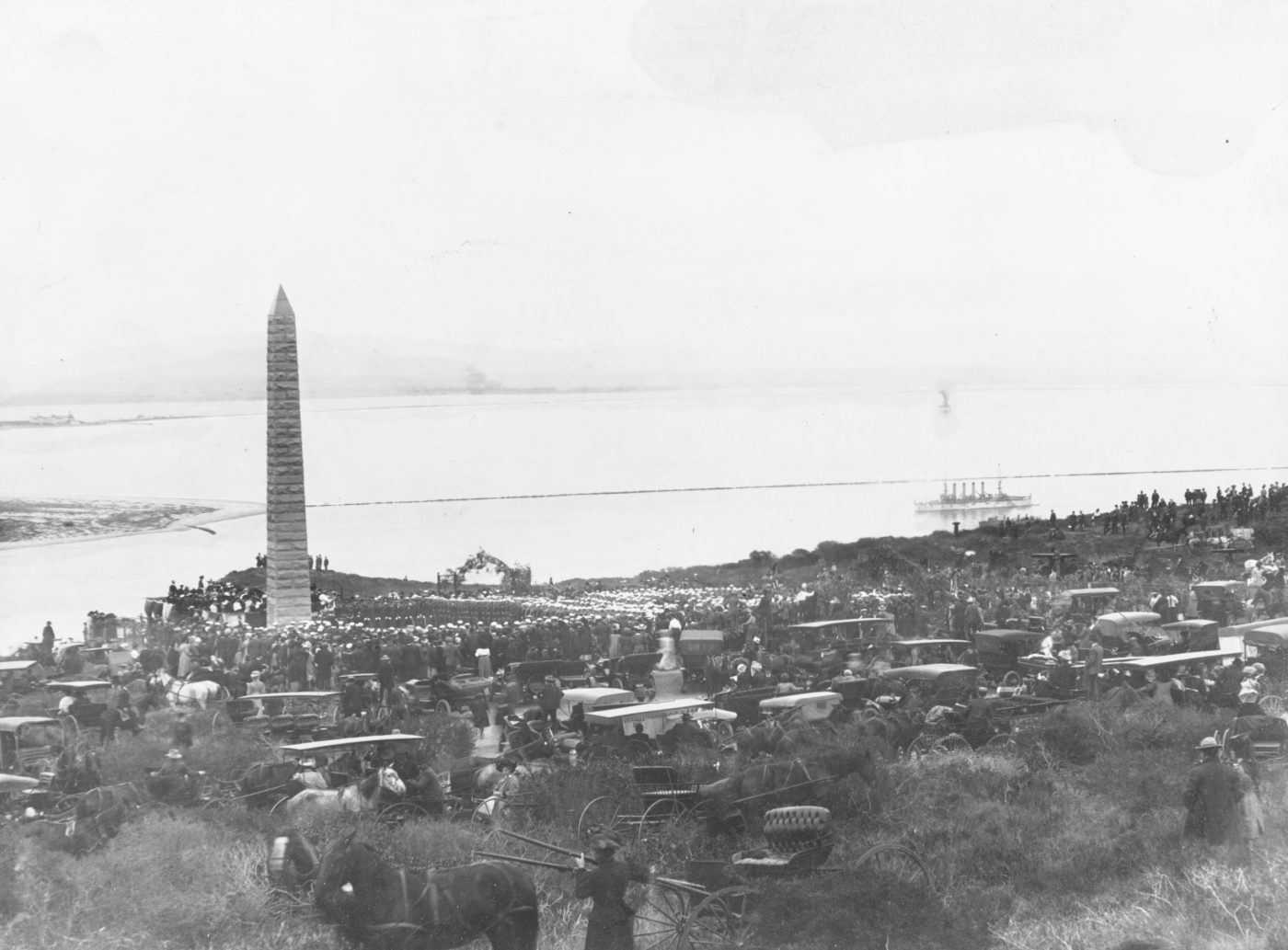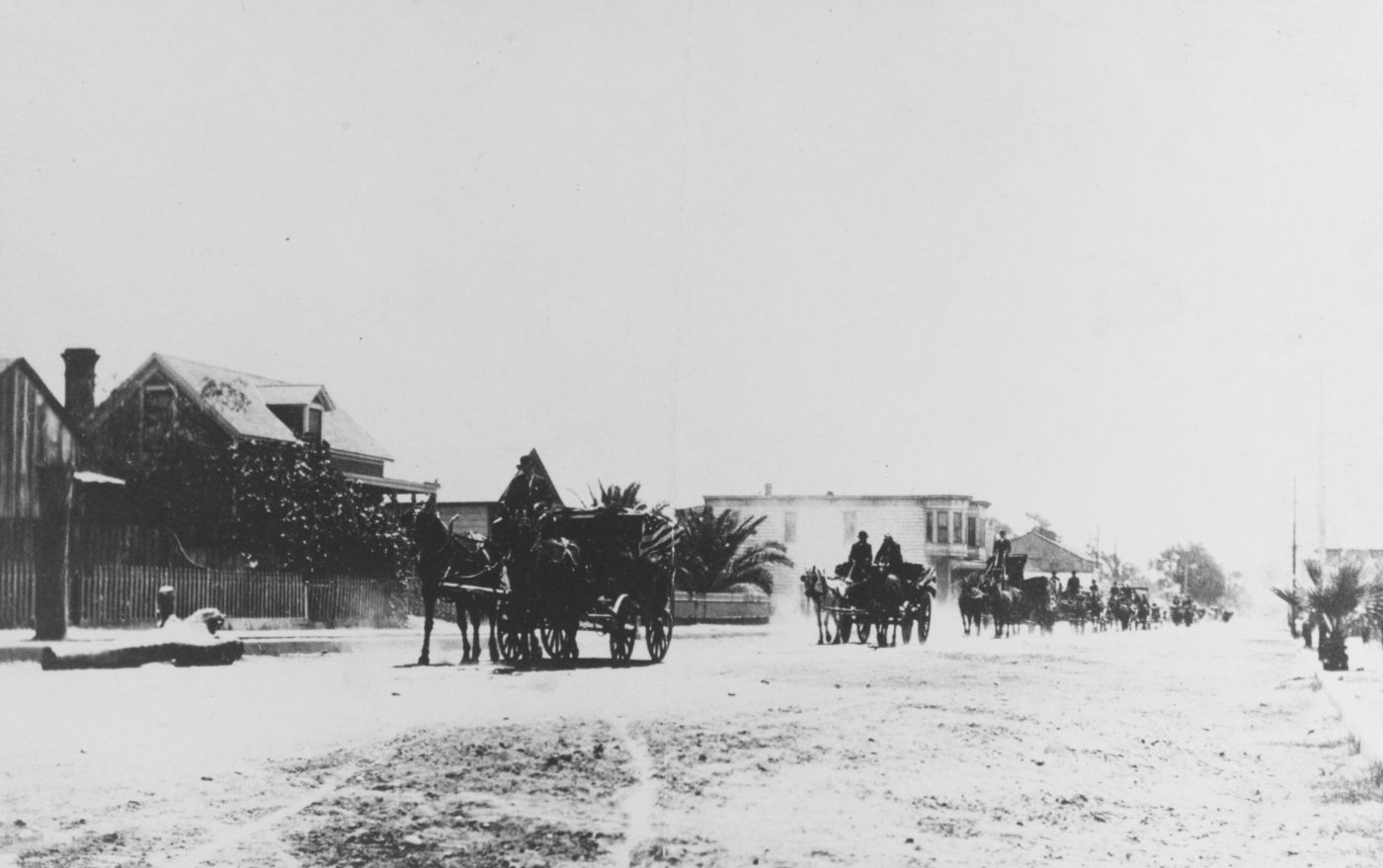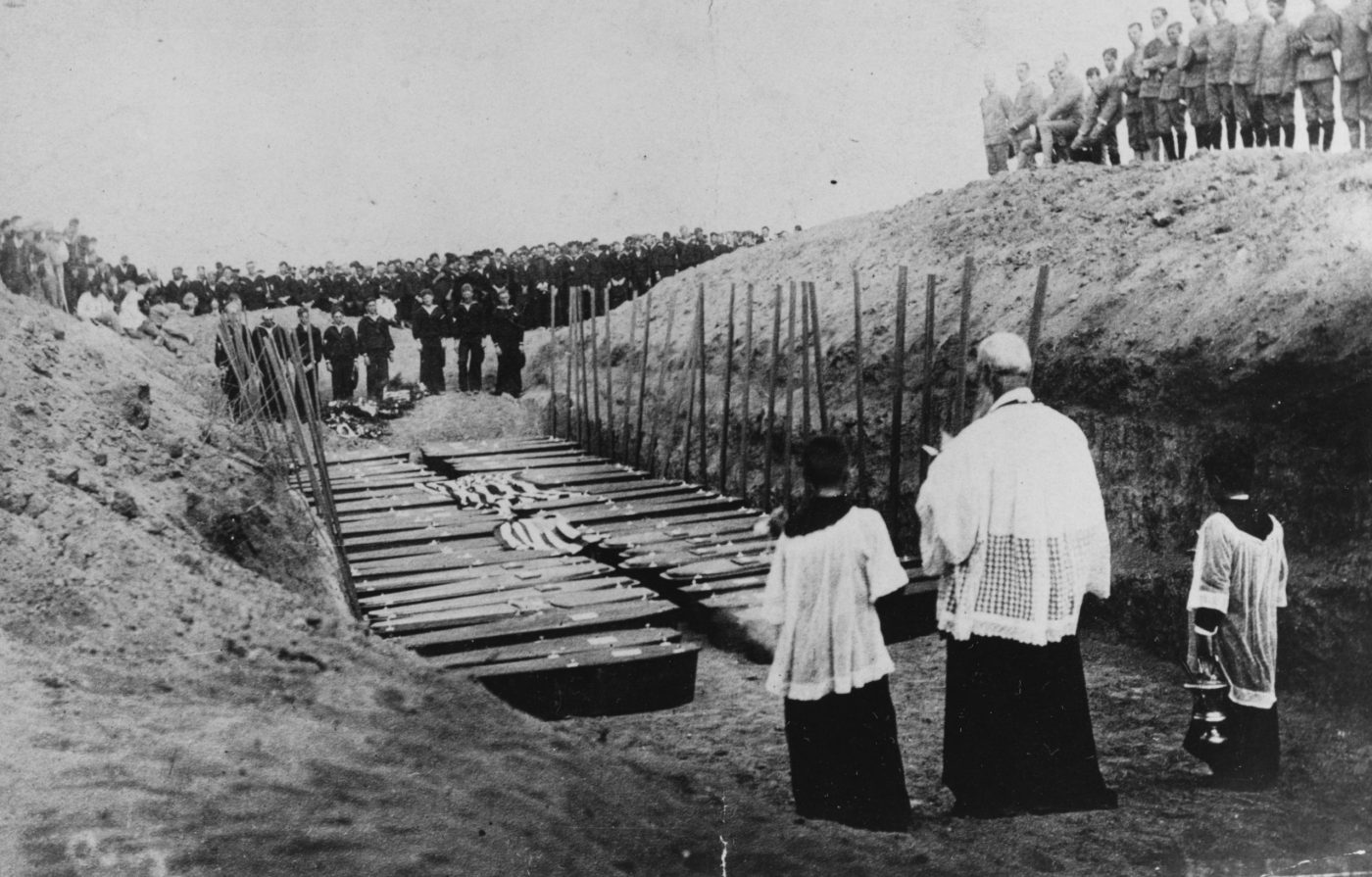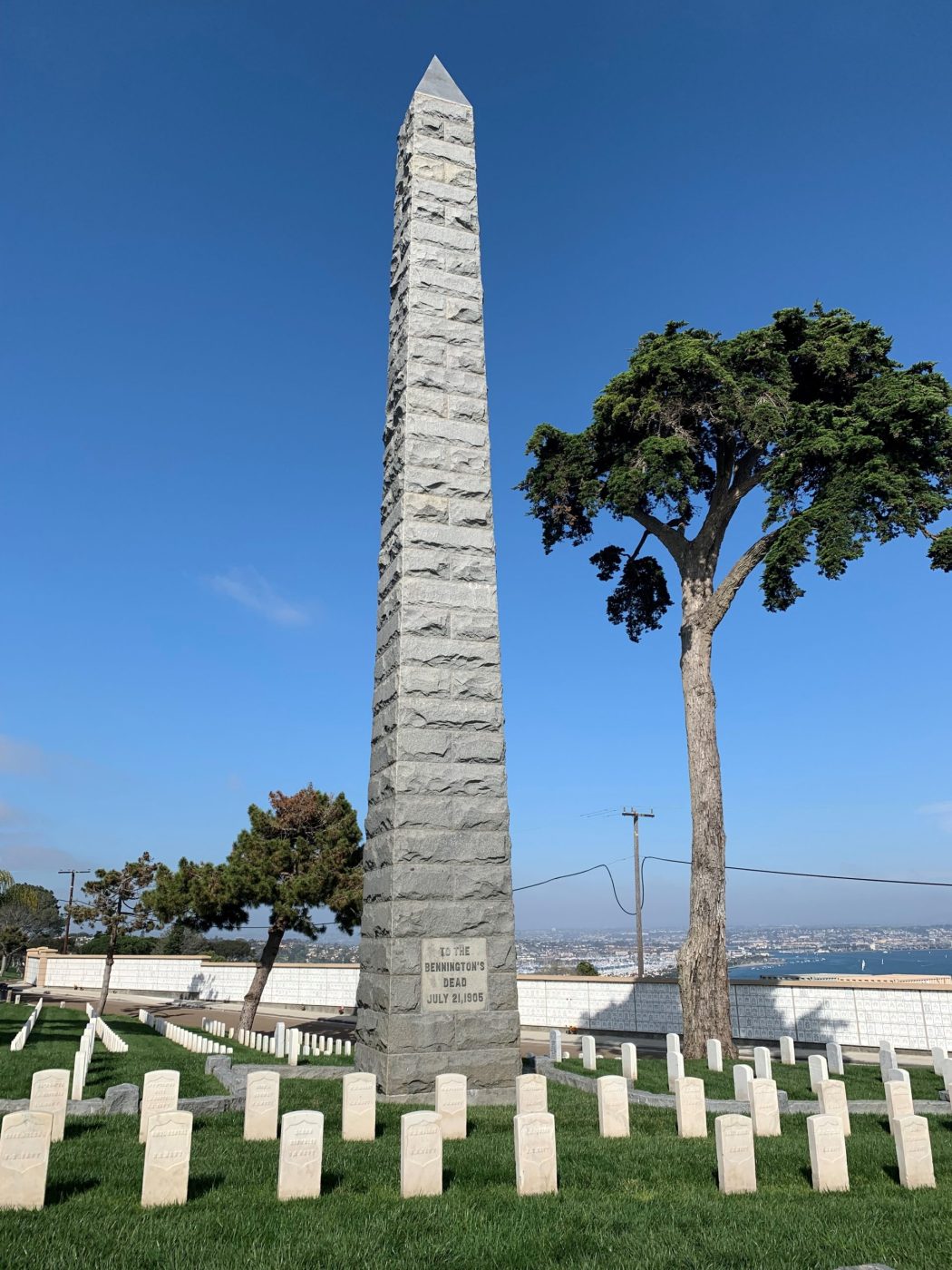
A somber procession of eight horse-drawn dray wagons left the central plaza of downtown San Diego at precisely noon on July 23, 1905. Typically loaded with heavy trade goods, these drays collectively carried 49 pine coffins holding the remains of sailors killed two days prior in the boiler explosion of the steel-hulled gunboat USS Bennington. On each wagon, the wreath-adorned coffins were stacked three high and draped with an American flag.
The grim, half-mile-long procession travelled without pomp or ceremony, per the Bennington commander’s request, on a jostling ten-mile dirt road leading around San Diego Bay and upward to the Fort Rosecrans post cemetery overlooking the city from the eastern bank of Point Loma. As the cortege slowly moved up the steep road, shrouded in thick dust, it gained hundreds of followers.
After hours of hard going, the wagons reached their destination. Fifty-two of the surviving Bennington crew, ferried across the bay on boats, awaited their fallen shipmates. Each wagon was unloaded by Bennington sailors and the coffins placed head-to-head in a long parallel row within a large, freshly dug trench.
As the coffins were placed and inspected, it was determined that two had been claimed by families for shipment home and had to be sent back to the city morgues. The exhausted onlookers, not permitted into the cemetery, watched from afar along the cemetery’s whitewashed fence. Once the 47 coffins were in place, Episcopalian and Catholic burial rites were performed over them. The Bennington’s captain, Commander Lucien Young, then stepped out from the crowd to the lip of the trench and entrusted the remains of his crew to the fort’s commander with the hope that:
their graves never be forgotten by the hand of affection. May there rise above this, their last resting place, marble slabs to mark the place as sacred to the nation’s care, and may the morning sun ever kiss the green sod above their dust, emblematic of our love and affection.
Then, Taps played, three rifle volleys resounded, flowers were placed upon the coffins, and events concluded by 4:30 p.m.

The Bennington explosion, heroic exploits of the crew, and the subsequent Navy investigation captured national attention. It was among the deadliest peacetime accidents in U.S. Navy history and claimed more lives than the Navy had lost in the nation’s most recent conflict, the Spanish-American War. Planning for a monument began immediately after the accident; in fact, the idea for a monument was born as naval officers returned across the bay aboard their launches following the funeral. Because Bennington belonged to the Navy’s Pacific Squadron, its leaders took the initiative and formed an association with the hope that each sailor in the squadron would donate up to $5 for a monument.
Concurrently, a separate Bennington Memorial Association was formed primarily by members of the San Diego community. This public group envisioned memorializing the lost crew with a recreational center for sailors in the city center, but sufficient funds never materialized. Some of the money they raised for a Bennington monument was offered to the Navy’s own efforts, but these funds were declined. In the words of Admiral Caspar Goodrich, Pacific Squadron commander, “it was our own tribute to our own comrades, we held it with a jealousy which can only be understood by those who have, themselves been called upon to make the greater sacrifice.”
The Pacific Squadron quickly raised the $5,500 needed for a monument. The design chosen was a simple obelisk made of roughhewn San Diego granite and capped with a polished granite pyramid. It was intended to make “no pretense to elaboration or . . . ornamentation for it merely commemorates the heroism of simple men whose sole guiding motive was devotion to duty.” Two polished panels were inscribed on the front and back of the monument. The north front face reads: “Erected by the Officers and Men of the Pacific Squadron in memory of those who lost their life in the performance of duty.”
The other side states: “To the Bennington’s dead July 21, 1905.” The monument was placed at the plot of the Bennington dead in the Fort Rosecrans post cemetery. The section contained only 35 graves by the monument’s January 7, 1908, dedication because the families of 12 other sailors had requested the return of their remains after the initial burial. The public Bennington Memorial Association funded a matching granite coping to enclose the burial plot. An estimated 2,500 attendees turned up for the monument’s dedication.
In 1934, the once remote Fort Rosecrans post cemetery was designated a national cemetery. Over the next 30 years, it increased in size from 8 to 70 acres to accommodate the growing demand for Veteran burial spaces spurred by the two world wars. The tall Bennington monument is still one of the most recognizable features of the cemetery, although tree growth makes it almost invisible from the military hub of Coronado below. Between April and November 2010, both the monument and burial enclosure underwent substantive repair and preservation.
One officer and 65 sailors, one-third of the ship’s company, lost their lives in the explosion. Eleven crew members received the Medal of Honor for their efforts in the aftermath of the explosion. Four of those men are buried in national cemeteries, including Boatswain’s Mate William Cronan, who rose to the rank of Lieutenant Commander and was laid to rest at Fort Rosecrans in 1959.
By Richard Hulver, Ph.D.
Historian, National Cemetery Administration
Share this story
Related Stories

History of VA in 100 Objects
Object 96: Postcard of Veterans Vocational School
In 1918, the government created the first nationwide vocational training system to help disabled Veterans acquire new occupational skills and find meaningful work. Over the next 10 years, more than 100,000 Veterans completed training programs in every field from agriculture and manufacturing to business and photography.

History of VA in 100 Objects
Object 95: 1840 Census of Pensioners
In a first, the 1840 census collected data on Veterans and widows receiving a pension from the federal government. The government published its findings in a stand-alone volume titled “A Census of Pensioners for Revolutionary or Military Services.”

History of VA in 100 Objects
Object 94: Southern Branch of the National Home
The Southern Branch of the National Home for Disabled Volunteer Soldiers opened in Hampton, Virginia, in late 1870. The circumstances surrounding the purchase of the property, however, prompted an investigation into the first president of the National Home’s Board of Managers, Benjamin Butler.




